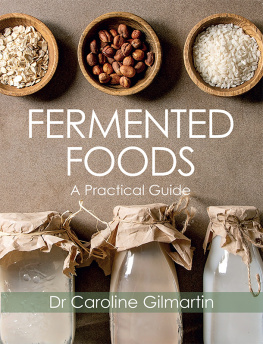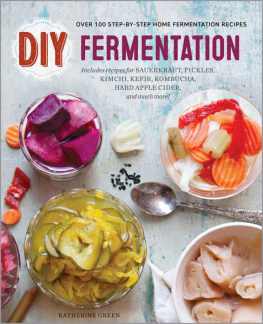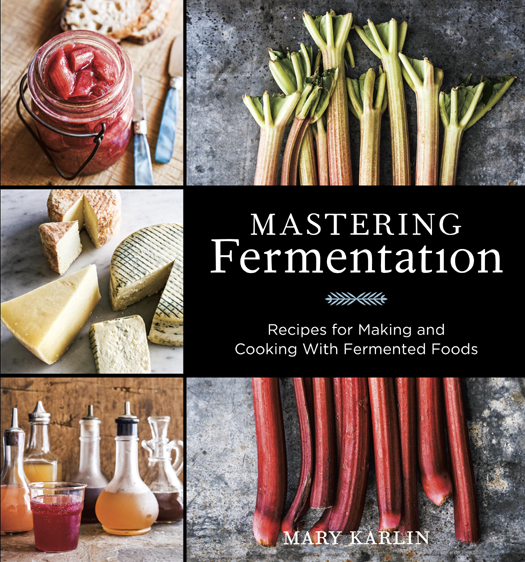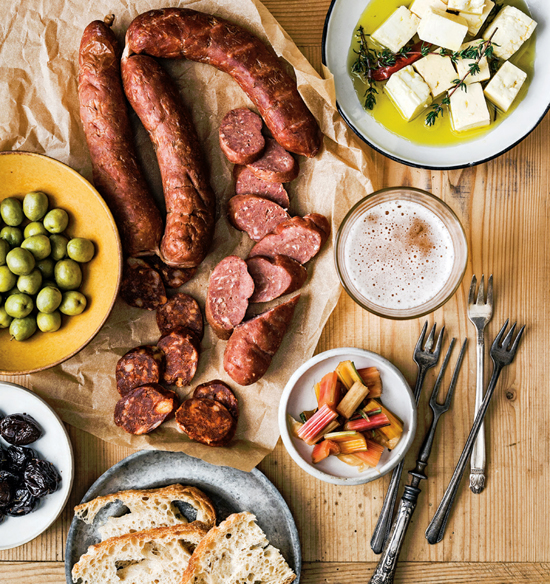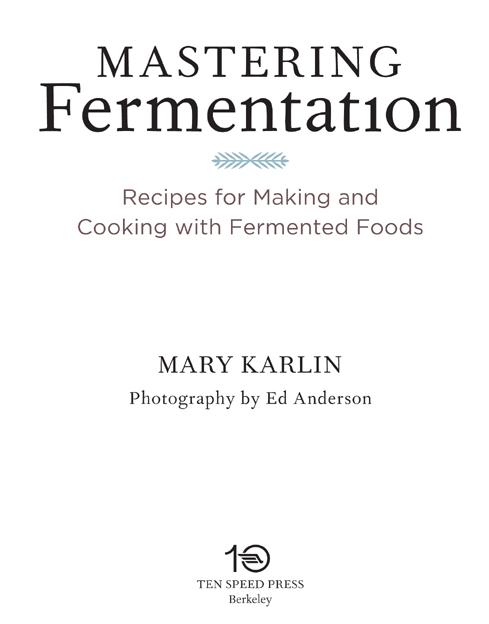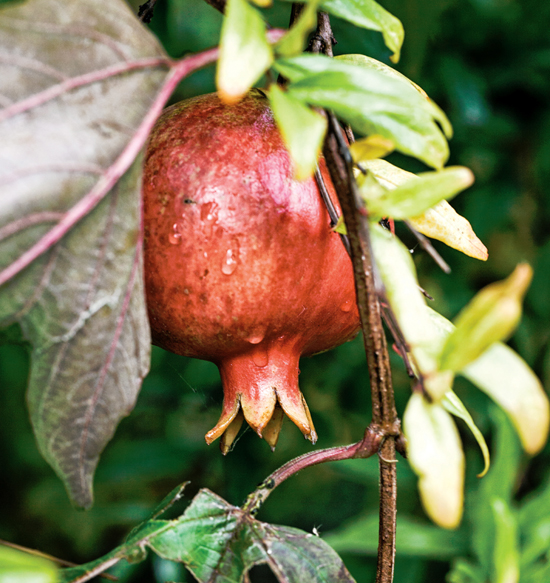Some of the recipes in this book include raw eggs, meat, or fish. When these foods are consumed raw, there is always the risk that bacteria, which is killed by proper cooking, may be present. For this reason, when serving these foods raw, always buy certified salmonella-free eggs and the freshest meat and fish available from a reliable grocer, storing them in the refrigerator until they are served. Because of the health risks associated with the consumption of bacteria that can be present in raw eggs, meat, and fish, these foods should not be consumed by infants, small children, pregnant women, the elderly, or any persons who may be immunocompromised. The author and publisher expressly disclaim responsibility for any adverse effects that may result from the use or application of the recipes and information contained in this book.
Copyright 2013 by Mary Karlin
Photographs copyright 2013 by Ed Anderson
All rights reserved.
Published in the United States by Ten Speed Press, an imprint of the Crown Publishing Group, a division of Random House, Inc., New York.
www.crownpublishing.com
www.tenspeed.com
Ten Speed Press and the Ten Speed Press colophon are registered trademarks of Random House, Inc.
Library of Congress Cataloging-in-Publication Data
Karlin, Mary.
Mastering fermentation : recipes for making and cooking with fermented foods / Mary Karlin ; photography by Ed Anderson.
pages cm
Includes bibliographical references and index.
1. Fermented foods. 2. Fermentation. I. Anderson, Ed, photographer. II. Title.
TP371.44.K35 2013
664.024dc23
2013002413
eBook ISBN: 978-1-60774-439-9
Hardcover ISBN: 978-1-60774-438-2
v3.1
I NTRODUCTION
S OURDOUGH BREAD, CHEESE, YOGURT, beer, wine, sauerkraut, kimchi, sweet chile sauce, soy sauce, pickles, and even chocolate are just a few of the fermented foods that are part of our everyday diets. In the United States, we love a wide variety of savory and sweet ferments that many of us probably dont even realize are fermented.
Have you ever noticed that many cuisines serve fermented foods with their meals? In Asian cuisine, its a small dish of pickled vegetables or spicy kimchi; in Indian cuisine, a fabulous chutney or lentil dosa; in the Mediterranean, an aromatic herbal beverage after the meal. Yes, these fermented foods and beverages are delectable players in the overall dance of flavors, textures, and tastes of a meal, but just as important as their flavor, ferments play a valuable role in the digestion of the meal and subsequent health of our digestive system. Fermentation makes those foods more digestible and therefore more nutritious. Its a bonus that fermented foods also taste great.
In many supermarkets today, overprocessed versions have replaced many foods that were traditionally fermented: processed cheese has taken the place of farmhouse Cheddar, pasteurized beers that all taste alike have overtaken regional ales and lagers, preservative-laden bread has replaced homemade loaves made with natural starters. The abundance of these foods throughout our food system makes us believe that these processed versions are safer and healthier for us. But they are not. Many ready-made foods have been robbed of many of their naturally occurring beneficial microorganisms by pasteurization and some extreme high-temperature food-safety processes such as ultra-pasteurization. Not all bacteria are bad for us. The presence of certain bacteria is essential to good health. It is important to our overall health that we get back to the practice of having real fermented foods as key elements of our diets. This is not a fad but a trend back to foods that are good for us, many of which we can make ourselves. Once youve tasted real fermented foods, youll want to stick to them, if only because they simply taste better .
So why do fermented foods taste so good? Fermentation promotes the growth of desirable bacteria, molds, and yeasts in foods, either food-borne or through the introduction of various starters to create an enzymatic action that transforms the food into an elevated state of flavor and nutritive value. Acidified milk turns into creamy cheese, hard barley kernels mellow into refreshing beer, simple cabbage turns into sauerkraut.
While on this unpredictable fermentation path, youll discover numerous unexpected gifts that the foods give you. You may start out to ferment one specific food, and in the process of doing so, be given the bonus of one or more beneficial by-products, what I call many from one. As an example, you may start out to make a fruit vinegar or shrub and find that you have a delicious pulp by-product to turn into a marinade or use to flavor yogurt. That vinegar can become a tasty salad dressing or even flavor a carbonated beverage.
In Mastering Fermentation , I present a contemporary approach to fermenting popular, useful foods any cook would want in their pantry, as well as extensive tips and recipes for using these fermented foods. Ill share with you the many ways you can make delicious world-class ferments at home using safe, contemporary methods of fermentation and how to easily incorporate them into your cooking repertoire. You cant rush fermentation nor can you wield total control over it, but with proper guidance and encouragement, you can achieve a high level of success.
In addition to recipes for creating more than seventy fermented favorites are twenty-two globally inspired contemporary recipes featuring those fermented foods in . Once youve got a pantry (or refrigerator) bursting with flavorful ferments, its time to put them to good use.
I invite you to join me on this adventure into the intriguing world of fermentation. Together well explore some popular categories of cultured dairy and cheese, fermented fruits and vegetables, sourdough breads and sprouted grains, cured meats and fish, legumes and nuts, and of course fermented beverages. Beyond the pages of this book, youll find a companion websitewww.masteringfermentation.comfull of additional recipes, tips, charts, and Q & A sections designed to keep information current. Its also a way for us to keep in touch. Lets get fermenting!
CHAPTER 1
FERMENTATION BASICS
F ERMENTATION IS ONE OF THE oldest forms of preservation. During fermentation, microorganismsbacteria, yeasts, or moldsbreak down complex molecules into simpler substances, transforming the chemical composition of food and enhancing its nutritive value. Fermentation improves digestibility, deactivates antinutrient compounds (compounds found in foods that interfere with the absorption of nutrients during digestion) in some foods (particularly nuts and grains), and stimulates probiotic functions, which benefit gut flora development. Carbohydrates (sugar or starch) in some form must be present in order for fermentation to take place. Fermenting agentshelpers enlisted to encourage safe fermentationcome in various forms: salt, whey, a variety of brines, packaged starter cultures, wild yeast starters, and even alcohol. All types of fermentation result in the formation of preservative acids or alcohol.



